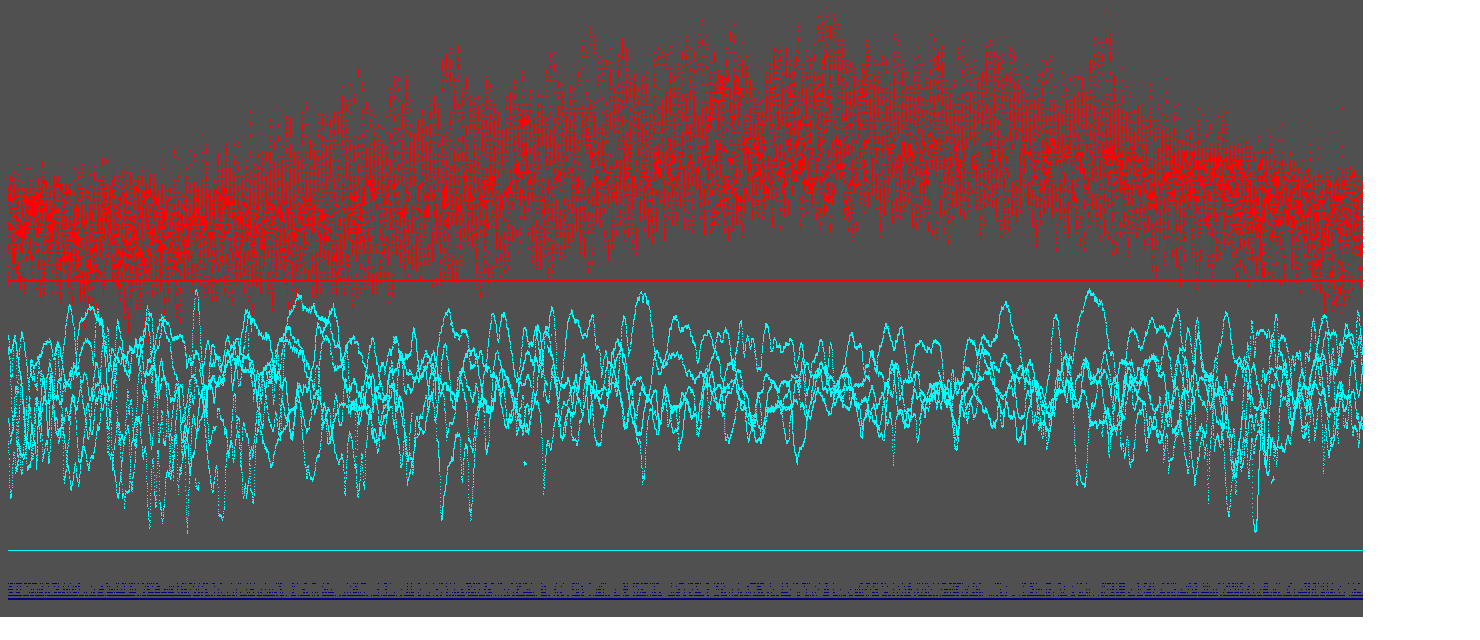
December to February have big pressure swings as depressions come in from the North Atlantic. Temperatures from late April to September are our 'summer', then a rapid drop in temperatures, but sub-zero ( Celsius) temperatures are rare and uually overnight.


The station saves data in the form of monthly files. I use 10 or 30 minute intervals usually. Also recorded are indoor temperature, outdoor humidity; wind direction and speed. Since the staion is close to a building and immediately above a dark-painted fence that gets full sun until mid afternoon the readings need to be 'taken with a pinch of salt', although consistent in themselves. It is possible to calculate cloud-base from the data- it is not directly measurable without access to lidar!
I'm interested in the periodicity of the depressions our trans-Atlantic cousins send towards the UK. Global warming seems to be giving us bigger extremes and less regularity through the seasons. I can plot things like daily temperature range, or time interval between successive depressions, or see if they correlate with the ( rather suspect) wind direction. And scope for unusual ( ?3D?) data presentations..
I used to download ( with LB from a website) a synoptic chart everyday. Unfortunately most modern sites use more sophisticated web frontends now which are harder to scrape.
By using LB I can very easily look at data over any chosen period. A typical program is shown- but I've used many variations.
Most of my data was on a 150G drive in a laptop, later re-purposed as an external drive. By a moments inattention- forgetting that Linux doesn't always use 'sba' for the external drive- I accidentally cloned a 8G Raspberry Pi image over the start of the drive. To recover data I had to use software that locates individual files, but doesn't know their names or types, unless that is, as with GIF, BMP, etc, encoded at the start-of-file. So I wrote various LB programs to identify my files via length, preamble or enclosed data. The remaining missing data is from battery change or other short episodes- or someone aiming a hosepipe at the rain sensor...
' ********************************************
' ********** cumulusYearGraphs.bas ********
' ********** ********
' ********** tenochtitlanuk ********
' ********** 14/05/16 ********
' ********************************************
' Creates custom graphs from data saved by weather stations.
' Station software updates a hard disk file whenever it is run,
' or at regular intervals if left running.
' This program reads, displays & saves data in ways the station prog. doesn't.
' The images/files saved can be used on a web page since converted to gif.
' The file is of ASCII data in csv form, defined below.
'1 Date in the form dd/mm/yy
'2 Current time
'3 Current temperature
'4 Current humidity
' Current dewpoint
' Current wind speed
'7 Recent (10-minute) high gust
'8 Average wind bearing
'9 Current rainfall rate
' Total rainfall today so far
'11 Current sea level pressure
' Total rainfall counter as held by the station
' Inside temperature
' Inside humidity
' Current gust (i.e. 'Latest')
' Wind chill
' Heat Index
' Oct 2010 to May 2016
' To-dos:-
' Save the bmp's with appropriate names.
nomainwin
WindowWidth =1500
WindowHeight = 700
UpperLeftX = 20
UpperLeftY = 20
graphicbox #w.gb, 0, 55, 1480, 640
statictext #w.st, "filename", 10, 02, 1100, 16
statictext #w.st2, "dateTime", 10, 25, 1100, 16
open "Cumulus datafile reader for all months" for window as #w
#w.gb "trapclose quit"
#w.gb "size 1"
#w.st "!font courier 12"
monthName$ ="Jan Feb Mar Apr May Jun Jul Aug Sep Oct Nov Dec"
monthLen$ ="31 28 31 30 31 30 31 31 30 31 30 31"
' ______________________________________________________________________
for year =10 to 16 ' data for years 2010 to 2016...
#w.gb "cls"
for month =1 to 12
skip =0
if year =10 and month <10 then skip =1: goto [bypass]
if year =16 and month > 5 then skip =1: goto [bypass]
' #w.gb "up ; goto "; xd; " 0 ; down ; color yellow ; goto "; xd; " 640 ; up ; goto "; xd; " 610 ; color black"
name$ =word$( monthName$, month, " ") +str$( year)
fn$ =name$ +"log.txt"
#w.st fn$;
open fn$ for input as #file
[data]
line input #file, row$ ' Extract row of 11 data items.
date$ =word$( row$, 1, ",") ' Extract date and separate into d/m/y.
days =val( mid$( date$, 1, 2))
months =val( mid$( date$, 4, 2))
years =val( mid$( date$, 7, 2))
tim$ =word$( row$, 2, ",") ' Extract time and separate into hrs/mins.
hrs =val( mid$( tim$, 1, 2))
mins =val( mid$( tim$, 4, 2))
minutes =mins +60 *( hrs +24 *days) ' Calc. minutes since day start.
yearDay =days +hrs /24
for cnt =1 to months -1
yearDay =yearDay +val( word$( monthLen$, cnt, " "))
next cnt
if years mod 4 =0 and months >1 then yearDay =yearDay +1
xPos =10 +int( 4 *yearDay)
#w.st2 date$; " "; tim$;
T =val( word$( row$, 3, ",")) ' outside temperature in rough range 0 --> 25
#w.gb "color red ; up ; goto "; xPos; " "; 280 -T *8
#w.gb "down ; goto "; xPos; " 280"
P =val( word$( row$, 11, ",")) -990 ' atmospheric pressure range 990 -->1040
#w.gb "color cyan ; up ; goto "; xPos; " "; 440 -P *3
#w.gb "down ; goto "; xPos; " 550"
R =val( word$( row$, 9, ",")) ' rainfall rate range 0 --> 3
#w.gb "color darkblue ; up ; goto "; xPos; " "; 598 -R *5
#w.gb "down ; goto "; xPos; " 599"
scan
if skip =1 then [data]
if skip =0 and not( eof( #file)) then [data]
close #file
[bypass]
next month
#w.gb "flush"
#w.gb "getbmp scr 0 0 1480 640"
pfb$ =str$( year) +"X.bmp"
'bmpsave "scr", pfb$
unloadbmp "scr"
'timer 5000, [continue]
'wait
[continue]
'timer 0
next year
' ______________________________________________________________________
wait
sub quit h$
close #h$
end
end sub